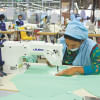Why are urban women disappearing from the manufacturing sector?

Despite rising exports and growth in the overall labour force, female employment in urban industries is collapsing. However, women in Bangladesh's manufacturing sector are not voluntarily leaving the workforce; they are losing their foothold in the industry.
Although total female employment in Bangladesh increased from 1.82 crore in 2013 to 2.37 crore in 2024, as per the Labour Force Survey (LFS) 2024, this growth has occurred almost entirely in rural Bangladesh. In urban areas, female employment has actually declined from 45 lakh to 39 lakh, while the urban female labour force participation rate has dropped sharply from 33 percent in 2013 to just 23 percent in 2024.
The data reveal that women are not leaving the workforce en masse; they are being pushed out of one sector in particular: manufacturing. Female employment in agriculture has nearly doubled, increasing from approximately 90 lakh in 2013 to 1.7 crore in 2024. However, in manufacturing, female employment has halved, decreasing from approximately 38 lakh to just 19.5 lakh during the same period.
The sharp decline in female employment in urban manufacturing is driven mainly by the ready-made garment (RMG) and textile industries. In 2012, Bangladesh exported $22 billion worth of RMG products. By 2024, that figure had reached $38.48 billion. Yet total RMG employment during this period did not increase at the same rate. Notably, the share of female employees in this sector has fallen during this time.
These trends point to several key reasons behind the crisis that we must ponder upon.
First, as any economics student learns early on, output can rise even as labour remains unchanged when production becomes more capital-intensive. This is precisely what is happening in Bangladesh's garment sector. Many factories have invested heavily in advanced machinery to stay globally competitive. These machines require less labour and fewer labour hours, reducing the need for workers to produce the same output. Women are often the first to lose their jobs in this transformation because they are concentrated in low-wage, entry-level roles such as cutting, packaging or working as helpers, precisely the jobs most vulnerable to automation. Studies estimate that up to 48 percent of jobs in the cutting section alone are at risk of automation.
Second, skill disparities between men and women aggravate this problem. LFS data show that men receive a far more diverse range of training in fields such as welding, driving, and computer-related skills, while most women are trained in RMG, craftwork, or beauty services. This lack of transferable skills severely limits women's options if they lose their manufacturing jobs, restricting their ability to transition into new sectors or take on new roles.
Third, Bangladesh has built an economic "cocoon" around the RMG industry, shielding it from competition and discouraging diversification. The sector enjoys several state-backed incentives such as duty drawbacks, bonded warehouse facilities, and direct cash benefits. They also face fewer regulatory and financial challenges than other industries, as evident from the World Bank Enterprise Survey (2022), which shows that RMG firms report some of the lowest obstacles in areas such as access to finance and tax administration.
In such a policy environment, why would businesses invest in non-RMG sectors when it is easier and more profitable to stay within the RMG sector? This monolithic focus dampens diversification and limits the emergence of new industries. Only the most determined or visionary investors venture beyond RMG, leaving the economy structurally dependent on a single sector and women with few alternatives once they lose their jobs in this particular industry.
A contrasting example is seen in East Asian countries such as Vietnam, China, Indonesia, Malaysia, and South Korea. As these countries moved across the value chain from RMG, they simultaneously nurtured new manufacturing and service sectors. Electronics, automobile production, logistics, and hospitality grew alongside RMG, widening employment opportunities for women. Bangladesh has yet to follow this path. Its failure to diversify means that when women lose manufacturing jobs, they often have nowhere else to turn.
Finally, structural barriers such as safety and security concerns, as well as the provision of childcare support, further constrain women's participation. The rising cost of living makes childcare increasingly expensive, and there are too few day-care centres and nurseries. As a result, many women are forced back into unpaid household labour or informal work. Education policies also contribute to the problem. The typical primary school day in Bangladesh lasts just four hours: from 8am to 11am or noon, compared to about seven to eight hours in most developed countries. Short school hours make it difficult for women with children to pursue full-time work, as they often have the responsibility to drop-off and pick-up their child from school.
The path to reversing these trends is difficult but not impossible. Bangladesh must place all manufacturing sectors on an equal footing, ensuring fair competition and reducing policy distortions that favour RMG alone. In other words, we need a robust diversification in the manufacturing industry. The government should also launch a large-scale reskilling initiative, for example, training 100,000 women each year, focused on cutting-edge machine operation, automation, driving, catering, and other skills aligned with future labour market demands. Training for care work, nursing and language skills could open up millions of overseas employment opportunities for women.
It is equally important to build a social infrastructure that supports working women. Accessible childcare, extended school hours, and after-school programmes would significantly increase women's ability to participate in formal employment. Extending school hours to 9am–3pm, with time allocated for play or extracurricular activities, would alleviate this burden. After-school care services could also help, allowing children to remain in a safe environment until their parents finish work. Expanding such support systems is essential for enabling women to participate in the urban manufacturing sector.
Women must not be confined to their homes. Instead, they must have the freedom to choose their future from various alternatives and the capacity to seize the opportunities that arise. This is what Amartya Sen described as "development as freedom." Ensuring this "freedom" is not optional, it is mandatory. As a nation, we must achieve it; otherwise, our society will go downhill.
Mahtab Uddin is assistant professor of Economics at the University of Dhaka and research director at the South Asian Network on Economic Modeling (SANEM). He can be reached at: [email protected].
Views expressed in this article are the author's own.
Follow The Daily Star Opinion on Facebook for the latest opinions, commentaries and analyses by experts and professionals. To contribute your article or letter to The Daily Star Opinion, see our guidelines for submission.

 For all latest news, follow The Daily Star's Google News channel.
For all latest news, follow The Daily Star's Google News channel. 











Comments